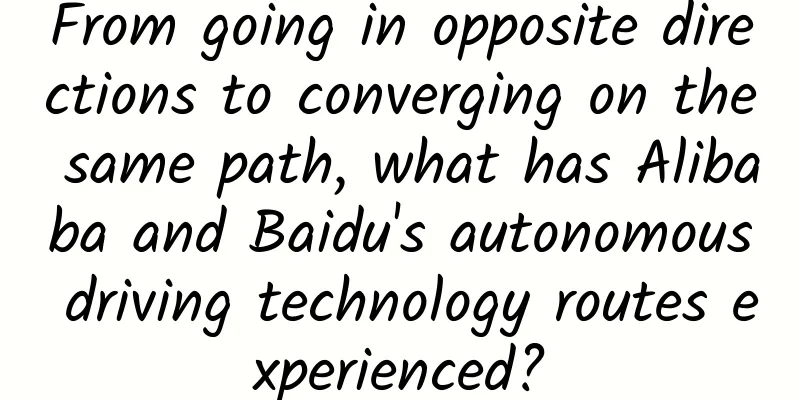From going in opposite directions to converging on the same path, what has Alibaba and Baidu's autonomous driving technology routes experienced?

|
Recently, Alibaba announced its autonomous driving technology route for the first time, focusing on achieving autonomous driving through the cooperation of autonomous vehicles and road infrastructure. At the same time, Alibaba DAMO Academy and the Ministry of Transport's Highway Research Institute announced the establishment of a joint vehicle-road collaboration laboratory. Subsequently, Baidu changed its previous focus on single-vehicle intelligence and announced that it would officially open-source the Apollo vehicle-road collaboration solution by the end of this year. Within a few days, the two giants competed to announce major technical routes, and both emphasized the importance of vehicle-road collaboration. With this, the direction of China's autonomous driving has also entered a unified thinking and a fast lane with different paths leading to the same destination. The shortcomings of bicycle intelligence Autonomous driving is an important part of automobile intelligence. Smart cars can meet people's more diverse needs. But smart cars are still cars in essence, and their core functions are still to carry passengers and goods. Compared with traditional cars, the most critical progress of smart cars should be the improvement of traffic safety and transportation efficiency, and on this premise, the cost should be reduced as much as possible, so as to gradually become popular. Currently, the mainstream technical path for autonomous driving is still single-vehicle intelligence. International leading autonomous driving players such as Google and General Motors mainly rely on sensors and artificial intelligence on vehicles, and use the assistance of high-precision maps to achieve autonomous driving. The first problem that single-vehicle intelligence faces is the high cost of sensors. Currently, the sensor equipment on self-driving cars accounts for about 40% of the cost of the entire vehicle, which means that only high-end cars can be equipped with self-driving functions. According to relevant forecasts, in 2023, the cost of sensors is expected to drop to 26% of the cost of the entire vehicle. Even if it drops to 26%, it is still too expensive for many vehicles. Expensive sensors have greatly limited the popularity of autonomous driving. Although autonomous vehicles have been imitating human driving behavior, they are ultimately different from human driving. Autonomous vehicles and human-driven vehicles driving together on the road actually make the traffic environment more complicated. If we simply rely on the intelligence of a single vehicle, we need enough autonomous vehicles to ensure safety. There may really be a day when the roads are full of self-driving vehicles, all of which travel at the same speed, with no more traffic jams or accidents, and transportation efficiency greatly improved. But this scenario is still too far away. Sensors have their own blind spots and usage conditions, and their performance will be greatly reduced in scenarios such as bad weather. High-precision maps can provide road condition information for autonomous vehicles and help them drive safely. However, high-precision maps are drawn in advance and are difficult to update in real time. Crowdsourcing is a relatively economical solution to the problem of HD map updates. However, the premise of implementing crowdsourcing is that there are enough vehicles that meet the requirements on the road. And whether the crowdsourced vehicles can fully cover all roads is also a question. Although HD maps can provide "memory" and updates for autonomous vehicles, they cannot ensure the safety of autonomous vehicles. The frequent occurrence of autonomous driving traffic accidents in the past not only shows that the existing autonomous driving technology is still imperfect, but also exposes the limitations of single-vehicle intelligence. Why develop vehicle-road collaboration? The biggest difference between vehicle-road collaboration and single-vehicle intelligence is the addition of intelligent road infrastructure. Alibaba calls it a vehicle-road collaboration perception base station, and Baidu calls roads equipped with this infrastructure "smart roads." This intelligent road infrastructure consists of a variety of sensors and computing units, which can be hung on the road like a camera, with one placed at a certain distance. This device can provide autonomous vehicles with information about surrounding road conditions, monitor emergencies in real time, and remind nearby vehicles to prepare in advance. With this device, real-time updates of high-precision maps are no longer a problem. This device can transmit changing road conditions to the high-precision map database in real time for corresponding updates. With the assistance of this device, the requirements for smart car sensors can be reduced, and the corresponding cost will also be reduced. This can promote the popularization of autonomous driving. In fact, part of the car sensors are transferred to public infrastructure, which can not only provide assistance for autonomous driving cars, but also transmit information to cars driven by humans. The utilization efficiency of sensors can be greatly improved, and the cost of autonomous driving can be more easily spread. Self-driving vehicles have gradually begun to be put into use. For example, Waymo's driverless taxis will soon be put into commercial operation. Human-driven vehicles and self-driving cars will eventually run on the same roads. The contradiction between the two has reached a point where it must be resolved. The significance of intelligent road infrastructure also lies in the communication between different vehicles, which involves the Internet of Vehicles. In the future, not all vehicles on the road will be self-driving vehicles, but every car will be connected to the Internet. The Internet of Vehicles allows passengers and drivers to use the Internet for entertainment and shopping, but this is not the real Internet of Vehicles. It is more accurate to say that it is in-car Internet access. The more important significance of the Internet of Vehicles lies in the communication between different vehicles. Human drivers can judge and predict the behavior of other vehicles based on experience. However, it is much more difficult for self-driving cars to make such judgments. Through the Internet of Vehicles, autonomous vehicles can obtain information about other autonomous vehicles and vehicles driven by humans, thereby breaking through perception blind spots and reducing misjudgments. This can not only reduce the occurrence of traffic accidents, but also reduce dependence on in-vehicle intelligence and consumption of in-vehicle computing resources. Compared with the United States, China's road environment is more complex and crowded, which poses a great challenge to the realization of autonomous driving. It is difficult for smart cars to adapt to such complex road conditions. Even if they can adapt, they will require more expensive sensors and higher-level artificial intelligence and computing power, and the overall cost will be very expensive. With the help of infrastructure, autonomous driving can adapt to more application scenarios, such as urban traffic scenarios, which are very difficult for autonomous driving. After all, autonomous driving that can adapt to most scenarios can truly liberate humans from driving work. Vehicle-road collaboration is not a simple negation of the intelligence of a single vehicle, but rather an extension of the intelligence of a single vehicle to the intelligence of the entire transportation system. In the short term, vehicle-road collaboration does not necessarily serve autonomous driving. The service base station of vehicle-road collaboration can first connect existing ordinary vehicles to the Internet, and then strengthen the dispatching and management capabilities of vehicles. This relatively basic application can achieve the effect of improving traffic efficiency. On September 14, Daimler and Bosch completed an automatic valet parking demonstration using a Mercedes-Benz E63. This Mercedes-Benz car had no driver and no sensors, but sensors were installed in the parking lot for intelligent transformation to help the vehicle complete automatic parking. The focus of this automatic parking solution is not on self-driving vehicles, but on vehicle networking and vehicle-road collaboration technology. The application scenario is for public parking lots. This actually reflects the trend of automotive artificial intelligence shifting to infrastructure. If this technology continues to develop, autonomous driving will rely more on the intelligence of infrastructure, and the role of the government in the autonomous driving industry will become increasingly important. Autonomous driving is an application area of artificial intelligence. Other artificial intelligence applications, such as smart homes, do not need to consider the issue of unified standards between different companies, and only need to be connected within a small area. Autonomous driving belongs to the public domain and involves safety issues; and the Internet of Vehicles and vehicle-road collaboration require unified standards. This requires that autonomous driving of different companies must be able to access unified standards. At present, my country is very determined to promote the autonomous driving industry and is very good at infrastructure construction. As autonomous driving evolves towards intelligent infrastructure, the government can play a better role and it is easier to unify standards. The establishment and unification of standards will also accelerate the popularization of autonomous driving. As a winner of Toutiao's Qingyun Plan and Baijiahao's Bai+ Plan, the 2019 Baidu Digital Author of the Year, the Baijiahao's Most Popular Author in the Technology Field, the 2019 Sogou Technology and Culture Author, and the 2021 Baijiahao Quarterly Influential Creator, he has won many awards, including the 2013 Sohu Best Industry Media Person, the 2015 China New Media Entrepreneurship Competition Beijing Third Place, the 2015 Guangmang Experience Award, the 2015 China New Media Entrepreneurship Competition Finals Third Place, and the 2018 Baidu Dynamic Annual Powerful Celebrity. |
Recommend
Home page operation strategy: Home page operation skills
The following is the framework directory of the e...
The maple leaves this year are not red enough, but these "coast guards" are really red...
Mangroves are woody plant communities that grow i...
How much does it cost to join the Wuhai food delivery app? What is the price for joining the Wuhai food delivery app?
Is it easy to join the Wuhai food delivery mini p...
Kuaishou live broadcast promotion introduction and delivery guide
I heard that you work very hard when you are live...
iOS 17 is about to be released, and it is reported that Apple iOS 16.6 Beta test version will be launched soon
According to Macrumors, reliable sources said tha...
We found the customer base, but failed in the investment. Why is B2B marketing so difficult?
Under the new marketing concept, low-cost custome...
Upgraded SMS: "5G Message" will be launched within this year
The 5G era has arrived. Recently, China Telecom, ...
The most comprehensive information | All questions about new media and self-media are here!
In this great era, more and more people are cross...
Humanity’s current space technology is still at a crawl. Is there any hope of eventually getting out of the Milky Way?
This is a question that is often seen on the Inte...
What’s the matter with Air China suspending meals on some flights? Why did Air China suspend meals on some flights?
China Southern Airlines has introduced regulation...
In just a few minutes, this AI agent can learn human expert behavior
It only takes a few minutes to successfully imita...
Red alert! Super Typhoon Dusurui is coming with great force. How can we defend ourselves scientifically?
"Du Su Rui" is here! The Central Meteor...
Beware! Scammers are targeting "young people"! !
When it comes to telecom fraud, is this the image...
How to attract new users with a budget of 0? 3 tips!
Attracting new users is the most basic task of us...
Tik Tok, are they really the next operational frontier?
Since April, I have repeatedly heard that the ope...









